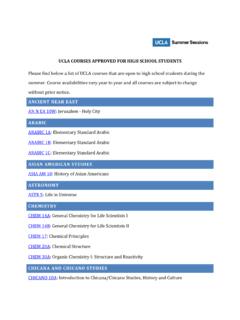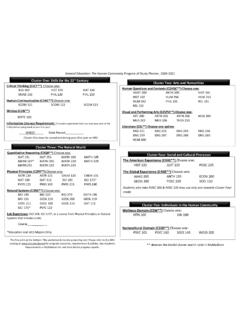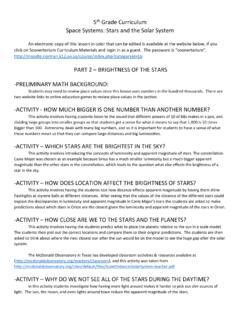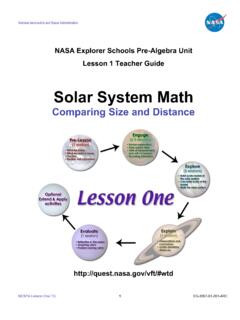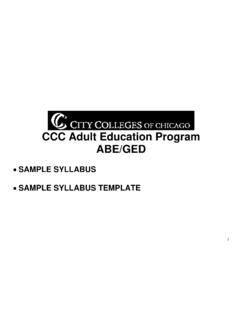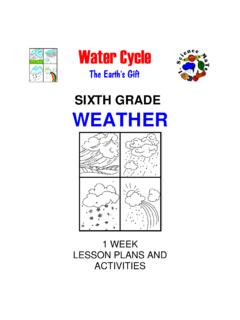Transcription of The Solar System - Start with a Book
1 Day 2. The Solar System Day 2. The Solar System 2. Introduction The Solar System is our Sun and everything that travels around it. There are planets, moons, comets, asteroids, and even dust and gas. All these objects travelling around the Sun are held in the Sun's gravity, making the Sun the center of the Solar System . Even though the distances between the Sun and the planets are enormous, gravity is great enough to hold the planets in orbit around the Sun. Questions to guide explorations and experiments What is the Solar System ? What is a planet? What planets are in the Solar System ? Why do the Earth and other planets revolve around (orbit) the Sun?
2 What else revolves around the Sun? How big is the Solar System ? How big are all the planets? Books and activities Books: fiction, nonfiction and poetry all about our Solar System Activities: explore the size of the planets in our Solar System and how far they are from the Sun 24. Day 2: The Solar System Children's Books 2. Fiction The Lizard and the Sun / La Lagartija y el Sol by Alma Flor Ada (Ages 4-8). Pluto Is Peeved: An Ex-Planet Searches for Answers by Jacqueline Jules (Ages 6-9). Miss Tracy Is Spacey! by Dan Gutman (Ages 6-9). Stink: Solar System Superhero by Megan McDonald (Ages 4-8). Zathura by Chris Van Allsburg (Ages 4-8).
3 Poetry Comets, Stars, the Moon, and Mars: Space Poems and Paintings by Douglas Florian (Ages 6-9). The Day the Universe Exploded My Head by Allan Wolf (Ages 9-12). Biography Caroline's Comets: A True Story by Emily Arnold McCully (Ages 6-9). Nicolaus Copernicus: The Earth Is a Planet by Dennis Fradin (Ages 9-12). Galileo's Universe by J. Patrick Lewis (Ages 9-12). I, Galileo by Bonnie Christensen (Ages 6-9). The Librarian Who Measured the Earth by Kathryn Lasky (Ages 9-12). The Planet Hunter: The Story Behind What Happened to Pluto by Elizabeth Rusch (Ages 4-8). Starry Messenger: Galileo Galilei by Peter Sis (Ages 6-9). Nonfiction Comets, Meteors, and Asteroids: Voyagers of the Solar System by Ellen Lawrence (Ages 6-9).
4 Exploring Our Solar System by Sally Ride and Tam O'Shaughnessy (Ages 9-12). Gravity by Jason Chin (Ages 6-9). Little Kids' First Big Book of Space by National Geographic Kids (Ages 4-8). The Magic School Bus Lost in the Solar System by Joanna Cole (Ages 6-9). Magic School Bus Presents: Our Solar System by Tom Jackson (Ages 6-9). 25. Day 2: The Solar System Children's Books 2. Nonfiction Me and My Place in Space by Joan Sweeney (Ages 4-8). Our Solar System by Seymour Simon (Ages 6-9). The Planets by Gail Gibbons (Ages 6-9). The Planets in Our Solar System by Franklyn Branley (Ages 4-8). Professor Astro Cat's Solar System by Dr.
5 Dominic Walliman (Ages 6-9). Science Comics: Solar System : Our Place in Space by Rosemary Mosco (Ages 9-12). The Sun Is Kind of a Big Deal by Nick Seluk (Ages 4-8). The Sun: Our Nearest Star by Franklyn Branley (Ages 4-8). What Makes Day and Night? by Franklyn Branley (Ages 4-8). Online fact sheets Small Worlds, Big Discoveries! by NASA. Asteroids: Space Rocks with a Story by NASA (also available in Spanish). 26. Asteroid Day 2: The Solar System Space Words Planet 2. A rocky space object that can be a few feet wide A celestial body that (1) is in orbit around the Sun, to several hundred miles wide. Most asteroids in (2) has sufficient mass to have a nearly round our Solar System orbit in a belt between Mars and shape, and (3) it is the dominant body in Jupiter.
6 Its orbit. Axis Revolve An imaginary line that goes To move in an orbit or circle around a fixed point. through a planet's center from The Earth revolves around the Sun. top to bottom. A planet spins (rotates) around its own axis. Rotate To turn around a center point or axis, like a wheel Comet turns on a bicycle. The Earth rotates from day to night. A frozen mass of gas and dust that orbits the Sun and may form a long, bright tail when it is flying Satellite close to the Sun. An object that orbits another object. A moon is a natural satellite. Dwarf planet A non-satellite body that is in orbit around the Sun, Scale has sufficient mass to have a nearly round shape, Scale is the implied relationship (or ratio) between but is not the dominant body in its orbit.
7 A model and the actual object. A scale model is a representation of an object that is larger or smaller Elliptical orbit than the actual size of the object being represented. The oval (not round) pattern that describes how the planets in our Solar System move around the Sun. Gravity A force that pulls matter together; a force that pulls people and objects toward the ground. Moon A natural satellite that orbits a larger object. Earth has one Moon, the one we see in the night sky. Orbit Solar System The curved path followed by an object in space The Sun and all of the planets, comets, asteroids, and as it goes around another object; to travel around other space bodies that revolve around it.
8 Another object in a single path. Star A giant ball of hot gas that emits light and energy created through nuclear fusion at its core. Sun The star in the center of our Solar System . Like all stars, the Sun is composed of a great burning ball of gases. It is made of hydrogen and helium. 27. Day 2: The Solar System Activity 1: Solar System Model (Distance). 2. Introduction Our Solar System is the Sun and everything that travels around it. Traveling around the Sun are eight official planets, at least five dwarf planets, nearly 200 moons (or natural satellites of the planets), and a large number of comets and asteroids. Supplies Tape measure Rolls of toilet paper Index cards or paper Markers Tape Solar System Statistics cards (See printable cards after page 45.)
9 The cards are set up to print double-sided.). 28. Day 2: The Solar System Activity 1: Solar System Model (Distance). 2. Get kids thinking Our Solar System is BIG! The sizes of the planets vary greatly as do the distances between planets and their distance from the Sun. Start by asking about distances kids have traveled. How many miles is it from home to school? How much time does the trip take? How long would it take and how many miles would you have to travel from where you live to get to London, England, or to La Paz, Bolivia? What about to Mars? Let's get started! Mars is relatively close to Earth, while the Sun and other planets even farther away.
10 Talk about scale and how good a way to show the vast distances among the planets is to make a scale model that is smaller than the actual size of the Solar System . Talk about the planets with the kids. Step 1: Identify the planets Ask kids: Can they can name all the planets in the Solar System ? As you name them together, have kids write each planet name down on its own index card or small piece of paper along with the average distance (in miles) of each planet from the Sun. These are big numbers, so share the distance chart on page 31 to help. Instead of writing, kids can cut out and use the Solar System Statistics cards.





